Pierre Mion – December 10, 1931 to July 16, 2021
It is somewhat of a cosmic coincidence that Pierre’s spirit left this Earth on the fifty-second anniversary of the day Apollo 11 left the planet on its journey to land humans on the Moon. Some of Pierre’s best known illustrations are his iconic depictions of that historic mission. Pierre Mion passed away on July 16, 2021. He was 89.
As a personal tribute, reprinted here is my account of when my wife and I found ourselves guests of Pierre and Sandy Mion for a day at their home in Arizona in 2017.
EDITOR’S NOTE:
A version of the following post was originally published June 2017 on pixel-planet-pictures.com.
A Day with a Space Art Icon
In the Spring of 2017, I had reached out to artist Pierre Mion to ask a question about the lunar landing painting that he collaborated on with Norman Rockwell. I had mentioned that I would be in Arizona for Spacefest and that it would be nice to meet him. His kind response included a suggestion that we come visit him. So, when the opportunity to meet Pierre in person arose, I made certain to modify our travel plans accordingly.
Pierre Mion is considered by many to be one of the iconic illustrators of space exploration and other scientific, architectural, historic and cultural subjects. Pierre enjoyed a thirty-eight year career as an illustrator for National Geographic Magazine, as well as Popular Science, Look, and many others. His meticulously detailed space illustrations accompanied articles about programs such as Surveyor, Apollo, Skylab, as well as envisioned missions to Mars.
Those who grew up in the early days of the space age may have first been introduced to Pierre’s artwork illustrating spacecraft and events of the U.S. space program. I distinctly recall, as a fourth grader in the late 1960s, seeing Pierre’s renderings depicting the events of the space race as it was unfolding. Those illustrations and the stories accompanying them made a lasting impression on me both artistically and scientifically.
Of the many excellent illustrations Pierre has produced, the ones that stand out in my memory are those that depict the Apollo lunar landing. As early as 1964, Pierre’s paintings of key Apollo mission events figured prominently in National Geographic Magazine. The first of Pierre’s images that I can remember personally from my childhood are the collaborations with Norman Rockwell for Look magazine, and the Apollo 11 lunar module paintings that appeared in the December 1969 issue of National Geographic. The National Geographic magazine issue documented the first Apollo lunar landing, complete with a flexible plastic pull-out record narrated by Frank Borman.
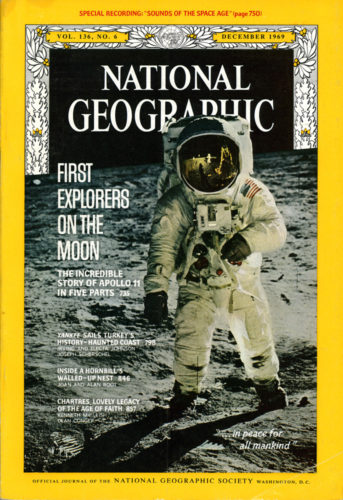
Two of Pierre’s paintings appear in the December 1969 issue of National Geographic. They show the two most critical parts of the Apollo 11 flight. The first shows Eagle approaching the large rocky crater that was situated in the computer-targeted landing site. The text accompanying the illustration describes how Neil Armstrong needed to take over manual control of the lander to bring the vehicle down to the surface safely. It was with a clear sense of pride and a touch of historic nostalgia, that Pierre stood up before us and read that passage aloud as he displayed the page with his work while we sat on the couch in his living room. For me witnessing this, it was an almost surreal experience that felt like time travel.
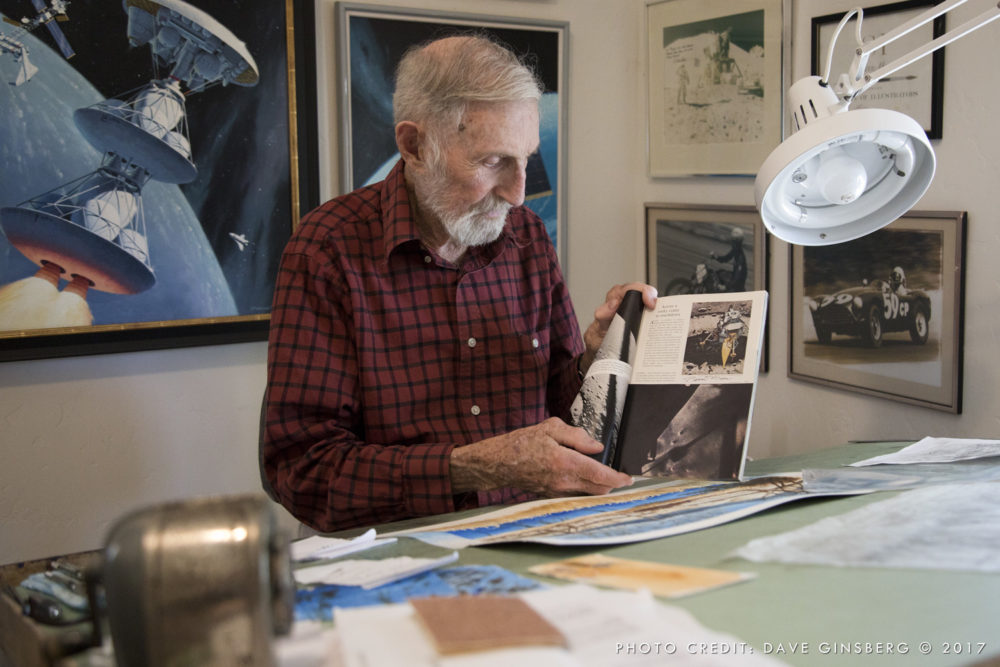
Pierre kindly agreed to sign some things for me, including two pages from the 1969 Apollo 11 issue of National Geographic. I had also brought with me for him to sign a 1966 issue of National Geographic School Bulletin, on which Pierre’s early version of the Moon landing appears as the cover illustration. The two versions of the LEM – one being a preliminary design from 1964 and the other being an as-flown version based upon photographs of the actual event – depict part of the rapid design evolution of the landing craft.
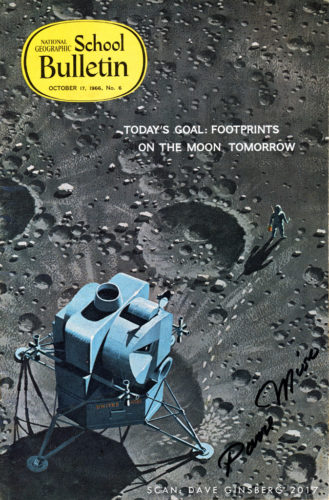
Pierre took painstaking care to accurately illustrate the Apollo 11 scenes. I had commented on the different approaches Pierre took to showing the footprints of the moon walkers in his two paintings separated by five years. The early one shows individual light colored boot prints dotted across the moonscape trailing the astronaut. It contrasts markedly with the 1969 version of the same scene, where the soil disturbed by the astronauts is colored darker than the surrounding lunar soil and the footsteps blend together to form roughened paths. The different depictions clearly show how artists had to go largely on conjecture of what the scene would look like several years prior to the actual event.
I have always found it interesting that even the engineers and designers of the lunar module left clear gaps of knowledge unfilled in the early stages of development. For instance, in the 1964 painting, there was no indication of how the astronaut would get down onto the surface from the LEM ascent stage. At that time, the engineers hadn’t yet incorporated a ladder into the design (though they did experiment with ropes at one point in development). Pierre decided to be true to the engineering of the day, as many others would have. The Apollo 11 illustrations are extremely accurate, right down to the placement of the items discarded by Neil and Buzz after their EVA, and the exact locations of the footpaths left behind. Pierre said that he used the film of the actual lunar liftoff to gain an accurate picture of how things were left at Tranquility Base.

Gouache, National Geographic December 1969
The walls in Pierre’s house are filled with original works by him, mostly of landscapes and scenery of Arizona and the Chesapeake Bay area. Above his couch, in a small alcove, hangs a memento of his time spent with Norman Rockwell – a flying cherub with an outstretched arm, and in whose hand is held a used paintbrush. Below this on the shelf is a small faded photograph of Norman Rockwell in his studio with the statue and its paintbrush hanging above him.
Pierre’s own studio is where the space-related items are located. Covering most of the wall behind the art table that belonged to his father (on which, incidentally, he was working on a new watercolor painting) are four large space paintings. Intermixed with those are other illustrations that have appeared in magazines and on their covers. Beside his chair are photographs that serve as a visual biography of the rich experiences he has had in his life. There are photos of himself in the Marines, driving race cars and motorcycles, and on a dive excursion with Jacques Cousteau. There is also a faded photo of Dave Scott on the plain at Hadley inscribed to Pierre. Nearly an entire shelf in his closet is devoted to books in which he has had his artwork published. To say that Pierre Mion has lived a full life would be an understatement.
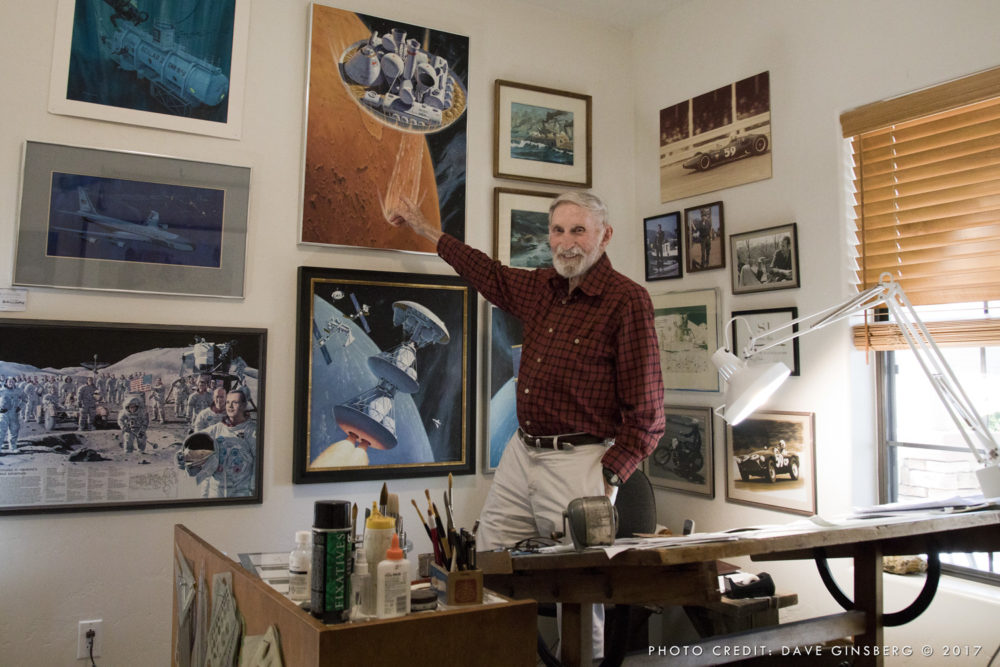
Toward the end of the day, Pierre led me into his garage where the most impressive portion of his collection resides. It was there from within the shallow slide-out drawers of a metal art storage unit that he began to pull out some of his cherished original artwork. Time permitted only one of those drawers to be explored, but what an outstanding one it was. The label on the front of the drawer said “National Geographic” in hand lettering that you would expect from a professional illustrator. One by one, out he pulled each incredible masterpiece. The subjects ranged from ship cutaways, to exhibit designs, to Aztec battles, to space art, of course. One of the space works was a beautiful scene of an orbital space station complete with astronauts pulling a satellite into a repair depot and a space shuttle – all these being of his own design. I detected a sense of style in this painting that was reminiscent of the work of Robert McCall. Pierre shared with me that he and McCall used to trade notes with each other about technique.
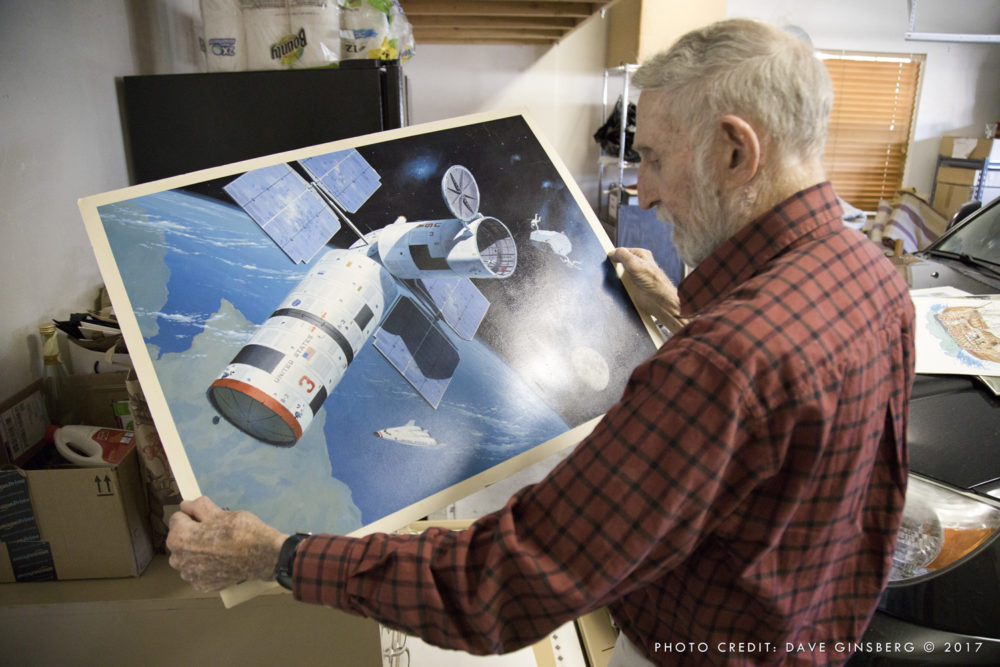
Pierre then came to the one I had been hoping to have the chance to see. It was the original painting of the Apollo 11 lunar module, Eagle, lifting off from the Moon. There, with the painting placed on top of the stack of his other priceless original artwork, Pierre began pointing out each of the features of the painting, including the craters and mission items that he precisely positioned based upon the mission photos and film. While I had the signed page from the magazine in hand, I couldn’t resist the impulse to only half-jokingly tell him that I would leave a space on my wall in case he ever gets tired of keeping the original.
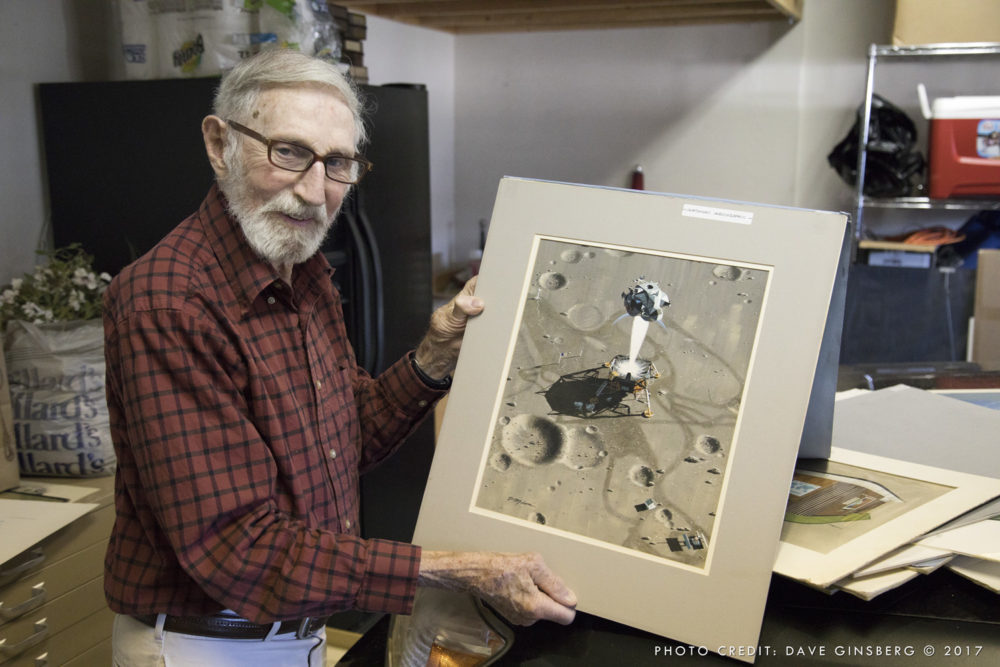
Until that time, I will be able to enjoy the items that he signed for me during our visit, plus a large limited edition print of a painting of Alan Bean and Pete Conrad of the Apollo 12 mission with the Surveyor 3 lander.

I will also enjoy the memories of our visit with Pierre and his wife. They were extremely kind hosts, and my wife and I greatly appreciate their invitation to come meet them and for the time they spent with us. It was a truly amazing and enjoyable, yet also down to Earth, experience we will never forget.
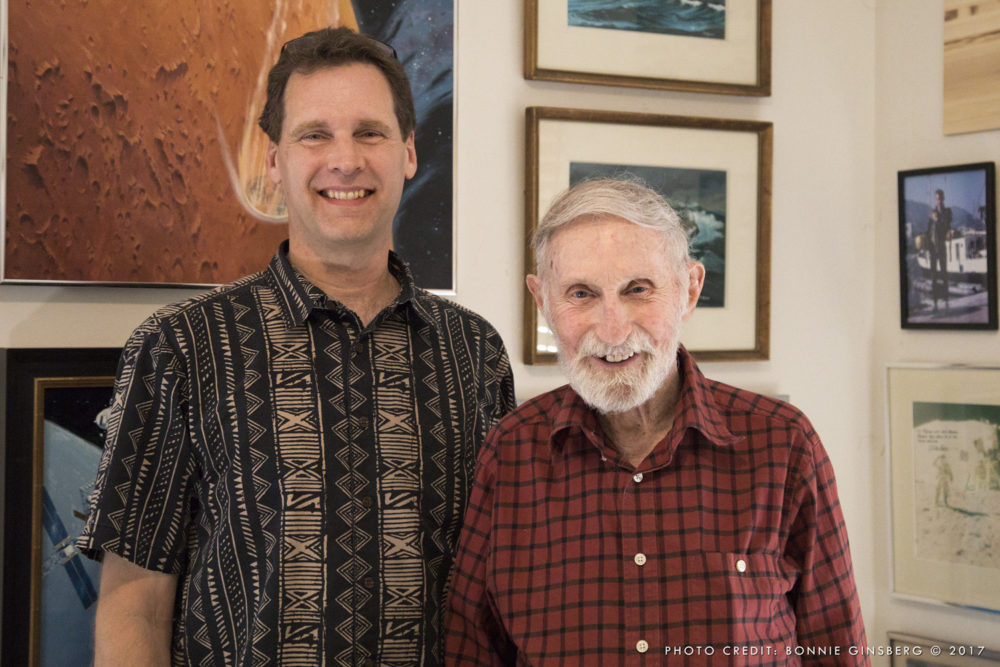
NOTE TO READERS
Creating Space has experienced a platform realignment. I’ve moved this blog over to Substack.
Please join me over at the new Creating Space blog and sign up for the free NERDSletter.
Read the new Creating Space here: daveginsberg.substack.com

(NOTE: This WordPress blog will continue to be available until I have moved the previous posts over to the new platform.)
All images and text copyright © Dave Ginsberg, unless otherwise noted. All rights reserved.